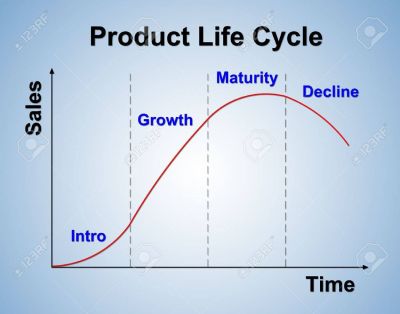Product Life Cycle Theory
Jump to navigation
Jump to search
The product life cycle is a description of the phases that a product category goes through from its inception to its ultimate withdrawal from the market. While some argue that the PLC applies to all product categories, there are some product categories that do not well fit the PLC framework. Water and salt cannot be displaced by substitutes. As seen in the image, sales and profits are positioned on the vertical axis, while time is on the horizontal axis.
The PLC framework consists of four stages:
- The introduction phase consists of the period between product launch and that point in time where growth starts to increase at a decreasing rate.
- Pricing: The firm may follow one of two pricing strategies during the introduction phase.
- Skimming, a higher price, is used to generate more immediate short term revenue and to more quickly recover initial investments.
- Penetration pricing, a lower price model than skimming, is used build market share and loyalty in anticipation of product maturity.
- Pricing: The firm may follow one of two pricing strategies during the introduction phase.
- The growth phase extends from the time that sales start to increase at a decreasing rate to an ill-defined point in time before sales start to peak.
- The Product Life Cycle Examples page provides several instances of industries that are in a long-term growth phase (COVID-19 may change the situation for some of the these firms).
- The maturity phase extends over a that period when a sales are at their maximum.
- This can be an extremely profitable stage of the product life cycle, especially if the the market is large and is sustained over a multi-year period.
- The Boston Consulting Group (BCG) defines a cash cow as a division or a product of a firm that is in the maturity phase of the PLC and has a large market share. Examples here include Budweiser (beer), the New York Times and the Wall Street Journal (national newspapers), Exxon Mobil (petroleum), and Michelin (rubber products). These companies have been generating over a long time horizon.
- Product development that elevates the value proposition for customers has the potential to shift a product category from the maturity phase back to a growth phase. This was the case for golf equipment supplier Callaway with introduction of the Big Bertha driver in 1991.
- The decline phase suggests that product sales have started to fall and will continue to fall toward an eventual withdrawal from the market.
- Residual demand in niche markets may persist for some time and this state may be profitable if the product is properly harvested.
- A number of products may be pointed out as having gone into significant decline over the past 50 years including typewriters, magnetic taps recorders, compact discs, and video cassette recorders.
